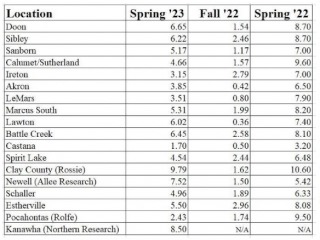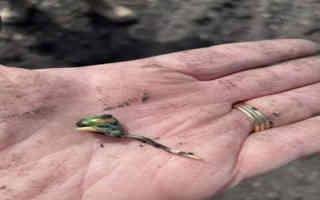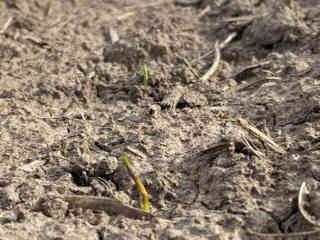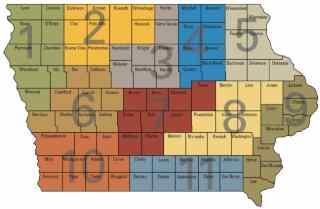
A comparison of subsoil mositures levels for the spring of 2022, fall of 2022, and spring of 2023.
Gentry Sorenson (Region 2): “Field operations have slowed in my region with the cooler temperatures and recent rainfall. Soil temperatures have been below 50 degrees with many areas in the low 40’s at the 4-inch soil depth. Before the rain, field operations consisted of tillage, fertilizer application, and some planting. Currently, many are assessing fields and making plans for this week and next week’s operations while evaluating current soil conditions vs expected forecasts. Recent questions have been about soil temperatures, forages, subsoil moisture, and planting.”
North Central Iowa
Angie Rieck-Hinz (Region 3): “Two weeks ago found us in a flurry of spring field work, including planting. Last week activity slowed down due to rain and cooler temperatures. What happens this week remains to be seen, but most folks are biding time as soils dry up and we look forward to warmer air and soil temperatures. Rainfall from April 1 through April 24 ranged from 3.8 inches at Mason City to 1.48 inches at Webster City with Webster City averaging a deficit of -0.85 inches for that time period. Across the counties I serve, we are currently averaging 20.8 GDDs above average from April 10 through April 24, but that has certainly been mitigated by the cooler temperatures of this past week. The big question of this week is should I be planting? Here are some things to consider. When we started planting around April 10, soil temperatures in NC Iowa were in the low 50s, but soil conditions were fairly dry. By April 14 soil temperatures were running in the upper 50s in my northern counties and the low 60s in my southern counties. Along came April 15 and the soil temperatures were down in the lower 50s and since then the temperatures have been hanging out in the lower 40s. When we think about planting this week, our soil temperature are colder than 2 weeks ago, and not predicted to hit 50 degrees until May 4, followed by a warming trend. Plus, our soils are wetter. Also, when I think back to April 10, the forecast was for a warm week, followed by a cooler week and then warming again. That forecast meant this would be a warmer week and here we are looking at least two more weeks of cooler temperatures. I tend to be a pretty conservative agronomist, so I might consider holding off on planting until after this weekend with the predicted colder temperatures and cold rainfall for this weekend."

Corn planted April 11, 2023 located in Northern Story County. Photo courtesy of Angie Rieck-Hinz.
Northeast Iowa
Terry Basol (Region 4): “Spring planting season started up on the week of April 10, with both corn and soybeans being planted here in NC and NE Iowa. Conducive weather temperatures and dry conditions also allowed growers to apply dry fertilizer, anhydrous ammonia, UAN, and begin herbicide applications. Cool and wet conditions have followed this past week, which resulted in a halt to planting, but as it’s dried up, some fertilizer applications have been occurring. According to the April 24th USDA NASS Crop Progress Report, 6% and 4% of the acres have been planted to corn in NC and NE Iowa, respectively. Additionally, about 65 – 70% of the oats have been seeded in my region. As far as precipitation, it started to rain on Saturday the 15th, and continued on and off through the week. According to the Iowa Mesonet, the NE Iowa Research and Demonstration Farm here at Nashua received 1.45” of rain for the period of April 15 through April 22. Here’s hoping the next couple of weeks brings us favorable planting conditions for Iowa’s farmers."
Josh Michel (Region 5): “Northeast Iowa had a flurry of field activity two weeks ago, followed by a week of anxiety and waiting as temperatures cooled down and many areas received four or more inches of snow. In addition to the snow we received last week, most of the area also received 1 - 1.5 inches of rainfall, with local heavier amount along the Minnesota border. Field operations, including dry fertilizer, anhydrous, and herbicide applications, occurred across the region as soil temperatures were hovering in the low to mid 50’s. We have also seen quite a bit of planting take place in some areas. Across the region, I’d estimate that around 60% of the oats have been planted, while only 5% of the corn and 10% of the soybeans. I’ve received many questions about planting conditions and Growing Degree Days. A great tool to help track GDD projections can be found here. With the cold temperatures over the past week, there’s also been several questions about soil temperatures and possible imbibitional chilling or cold injury to seeds. When it comes to four-inch soil temperatures, you can see past as well as forecasted soil temperatures on the Iowa Environmental Mesonet. Regarding forages, alfalfa fields and pastures continue to green up, but growth remains slow due to the cooler than normal temperatures. Other field calls and questions I’ve received over the past two weeks have centered around cover crop termination, corn rootworm management, soil fertility, alfalfa stand assessments, as well as pasture weed identification and management.”
Central Iowa
Meaghan Anderson (Region 7): “Central Iowa was off to the races after Easter with a lot of field activity, but has since screeched to a halt for most farmers between the rain and the cooler temperatures. Some of the earlier planted corn or soybean has accumulated nearly enough GDD to emerge. We’ll want to keep a close eye on those early-planted fields to monitor for emergence and any issues that may have resulted from the extended cold, wet period. The last week brought anywhere from about 0.5” to close to 5” of rain in my area, with Dallas County and NW Madison County getting the most. This week looks to have a steady warm up and hopefully people can return to the fields soon. For more information on planting date as it relates to yield, check out this 2021 blog by Mark Licht. Phone calls in the last week were about cover crop termination, herbicide rate calculations, weed identification, to plant or not to plant, and rotating a perennial stand back to corn or soybean.”
East Central, Southeast, and South-Central Iowa:
Rebecca Vittetoe (Region 8): “Two weeks ago we saw a lot of field activity ranging from fertilizer and herbicide applications to tillage and planting across EC Central Iowa. Last week’s cooler temperatures and rainfall meant limited to no field activity. Rainfall totals over the last week ranged from about a 0.25” to about 2” in some isolated areas. With the cooler temperatures, soil temperatures dropped into the 40s over the weekend and are hanging in the upper 40s right now. Some of the first planted corn and soybeans are starting to emerge. If you planted, be sure to keep an eye on those fields for any potential issues. Forages have really greened up. Based on growing degree days, we could expect to start seeing alfalfa weevil larvae being active. I can say I’ve seen adult alfalfa weevils when I did a quick sweep in an alfalfa field, but didn’t find any larvae, yet. Questions over the last two weeks have been on cover crop termination, planting, soil temperatures, frost/freeze concerns, and forages.”

Corn planted on April 10, 2023 in Keokuk County just starting to emerge on April 24, 2023. Photo courtesy of Rebecca Vittetoe.
Clarabell Probasco (Region 11): “Similar to much of the state, the south-central region has experienced some chilly temperatures and a couple evenings of frost threats. As of the April 24th USDA NASS Crops Progress report, 20% of the corn acres have been planted and just under 5% for soybean acres for SC Iowa. Soil temperatures are hanging around the upper 40s and look to stay in the upper 40s to lower 50s for the near future. There have been some precipitation events, making field work touch and go in many places. In the last 14 days, the area has accumulated 1-1.5" of rain. With the finicky weather, many producers found a good window to apply fertilizer to pastures. As soils dry and temperatures continue to rise, there will be a lot of action happening in fields across the region.”
Check out the map below to find your local ISU Extension field agronomist and find their contact information here!

Source : iastate.edu